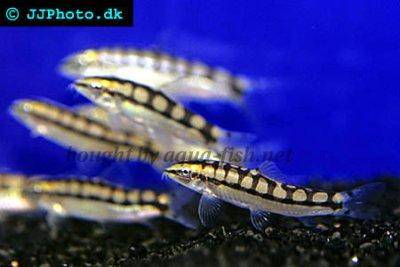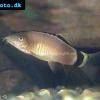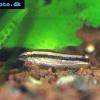Dwarf botia - Yasuhikotakia sidthimunki
Scientific name: Yasuhikotakia sidthimunki
Common name: Dwarf botia
Family: Botiidae
Usual size in fish tanks: 4 - 5 cm (1.57 - 1.97 inch)
014
Recommended pH range: 6.5 - 7
Recommended water hardness: 4 - 12°N (71.43 - 214.29ppm)
0°C 32°F30°C 86°F
Recommended temperature range: 25 - 30 °C (77 - 86°F)
The way how these fish reproduce: Spawning
Where the species comes from: South Asia
Temperament to its own species: peaceful
Temperament toward other fish species: peaceful
Usual place in the tank: Bottom levels
Food and Feeding
The Dwarf Botia is an omnivorous species with a preference for protein-rich foods. In their natural habitat, they feed on crustaceans, insects, and worms. In the aquarium, provide a balanced diet of high-quality sinking pellets or flakes supplemented with live or frozen foods such as brine shrimp, bloodworms, and daphnia. Incorporate algae wafers or spirulina-based foods into their diet to support digestion and overall health. Feeding small portions multiple times a day helps mimic their natural foraging behavior.
Origin
Yasuhikotakia sidthimunki, commonly known as the Dwarf Botia, originates from the river basins of Thailand, particularly in the Mae Klong, Chao Phraya, and Mekong river systems. Once thought to be extinct in the wild, these fish were rediscovered in the wild in Thailand. Despite this, they remain endangered due to habitat loss and overfishing, and most specimens in the aquarium trade come from fish farms.
Sexing
Sexing Dwarf Botias is challenging. The most noticeable difference between sexes is that females tend to appear slightly rounder or "pudgier" than males, particularly when they reach sexual maturity and are carrying eggs. Otherwise, there are no clear distinguishing features.
Breeding
Breeding Yasuhikotakia sidthimunki in home aquariums is extremely rare and has not been widely documented. Most individuals available in the aquarium trade are bred through artificial means in fish farms. In their natural environment, they are thought to be seasonal spawners, depositing eggs on submerged vegetation during the rainy season. For aquarists attempting to breed them, maintaining pristine water conditions, mimicking seasonal changes, and providing dense plant cover may help, although success is unlikely without specialized equipment and expertise.
Lifespan
With proper care, the Dwarf Botia can live up to 10 years, making them a long-term commitment for dedicated aquarists.
Tank Setup and Behavior
Dwarf Botias are active, social bottom dwellers that thrive in groups of at least five individuals. Their small size and peaceful temperament make them an excellent choice for community tanks. However, they can be shy, so providing plenty of hiding spots is essential. Decorate the tank with driftwood, caves, and plants like Java Fern or Cryptocoryne to mimic their natural habitat and reduce stress. A sandy or fine gravel substrate is recommended to protect their delicate barbels.
Ensure good water quality with regular maintenance and a moderate current to replicate their natural riverine environment. Keep the lighting subdued to encourage their activity and natural behavior.
Compatible Tankmates
The peaceful nature of the Dwarf Botia allows them to coexist with other small, non-aggressive species. Ideal tankmates include:
- Harlequin Rasboras – Colorful and peaceful mid-level swimmers.
- Ember Tetras – Gentle companions with similar water requirements.
- Pearl Gouramis – Calm and visually striking additions.
- Pygmy Corydoras – Small and peaceful bottom dwellers.
- Otocinclus Catfish – Complementary algae eaters.
Incompatible Tankmates
To avoid stress or injuries, do not house Dwarf Botias with larger, aggressive species such as cichlids or fin-nippers like tiger barbs.
Short Description
The Dwarf Botia is a lively and endangered species that brings energy and charm to community aquariums. Known for their unique patterns and social behavior, these fish thrive in well-planted tanks with plenty of hiding spots. Their manageable size, peaceful nature, and fascinating history make them a favorite among aquarists.
Pictures
Bought by aqua-fish.net from jjhpoto.dk.



 Skunk
Skunk  Black-lined
Black-lined